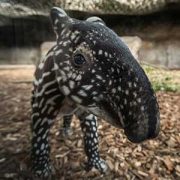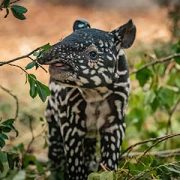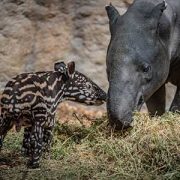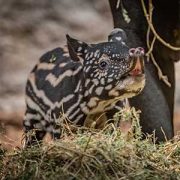So, a baby tapir has been born…
And here he is testing out his tiny trunk for the first time ? pic.twitter.com/FFcsjN32KX
— Chester Zoo (@chesterzoo) July 23, 2019
The calf, which has been revealed as a boy, arrived to proud parents Margery (7) and Betong (6) on Thursday morning (18 July).
Weighing just 5kg at birth, the ‘precious’ youngster follows a 13-month-long (391-day) pregnancy.
Keepers at the zoo are now asking the public to help them to give him a name.
Baby tapirs have distinctive coats when first born, made up of a series of spots and stripes to help camouflage them on the forest floors in their native South East Asia. This pattern will slowly change over the first six months to the unique black and white pattern of their parents.
Around half of the world’s Malayan tapirs have been lost in the last 40 years, with fewer than 2,500 estimated to remain in across Malaysia, Sumatra, Thailand and Myanmar. Hunting, illegal logging and mass deforestation as land is cleared for unsustainable palm oil production are blamed for the decline in numbers.
Conservationists have hailed this latest birth at the zoo with the species listed as endangered on the International Union for the Conservation of Nature’s (IUCN’s) Red List of Threatened Species.
The Malayan tapir is related to both the horse and the rhinoceros. It is an ‘odd-toed’ ungulate (or hoofed mammal), with four toes on each front foot and three on each back foot.
To celebrate the youngster’s arrival, keepers at Chester Zoo are inviting people to vote for his name via a poll on our Facebook page. Vote here
Malayan tapir facts
- Chester Zoo’s new Malayan tapir calf was born on Thursday 18 July at around 5am
- The zoo is part of a European breeding programme for the endangered species
- Malayan tapirs typically give birth to one calf after a 11-13 months gestation period
- The animals have unusual, long flexible noses that they use to forage for food, and are known for their unusual courtship ritual which involves an assortment of wheezing and whistling sounds. They will then sniff each other, walking around in circles before mating
- Malayan tapirs also have poor eyesight, which makes them rely heavily on their excellent senses of smell and hearing
- Young tapirs are born with spots and stripes all of their bodies to help provide camouflage against the forest floor of their natural habitat but lose those patterns in the first year of their life
Your zoo ADVENTURE starts right here! Plan your BEST DAY and explore Chester Zoo. There’s plenty to do – so make the most of your day out.



